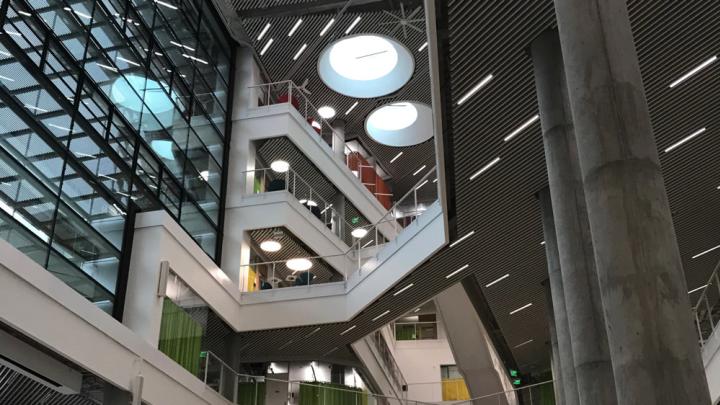Harvard leveraged construction of its massive new Science and Engineering Complex (SEC) in Allston in order to coax building-materials manufacturers into removing hazardous chemicals from their supply chains, the University reports. Heather Henriksen, the University’s principal sustainability officer, and Elsie Sunderland, the Gordon McKay professor of environmental chemistry, described their work with suppliers during a press call to announce that the SEC had earned the highest Leadership in Energy and Environmental Design rating (LEED platinum) from the U.S. Green Building Council.
The LEED rating system specifies standards for buildings that conserve resources by lowering energy and water use, using renewable and recycled materials in construction, and controlling erosion and storm water runoff. Such buildings also create healthy work environments by optimizing natural lighting, ventilation, and heat. While LEED-certified buildings can cost more to construct than conventional facilities (as reported in “An Allston Metamorphosis,” November-December 2006, page 66), they recover the additional investment through reduced operating and maintenance costs.
The 544,000-square-foot facility is also the largest building, and the first containing wet laboratories, to achieve certification from the International Living Future Institute (ILFI) in three areas: equity, beauty and—most notably—materials. Such certifications are even more difficult to achieve, explained Vivian Loftness, an ILFI board member who previously served on the U.S. Green Building Council. ILFI’s goal, she said, is to “create the greenest buildings possible for a healthy world and a sustainable climate.” Loftness, who is Paul Mellon Chair and University Professor at Carnegie Mellon University, said that because the SEC is the largest building ever to be certified under this standard, its impact has been transformational.
Sunderland, who is also professor of environmental science and engineering at the Harvard Chan School of Public Health (HSPH), has helped identify and verify the presence and absence of chemicals of environmental concern, particularly man-made chemicals called PFAS (per- and polyfluoroalkyl substances) that are used in rugs and other products. (See “The Global Chemical Experiment,” July-August 2018, page 39, to read more about her research on environmental pollutants.) She noted that Harvard’s sustainability office has been doing pioneering work to address toxic chemicals in building materials, calling these efforts “to push the field forward” in this way “very unusual.” In the SEC, she pointed out, “you will encounter healthier products in the walls, floors, ceilings, lights, furniture, paints, composite wood, wire coatings, pipes, plumbing sealants, countertops, and even lab equipment.” In all, the University evaluated and tested 6,033 different building materials. In some cases, simply requiring manufacturer labeling of ingredients led to changes in their product’s formulation. Working with a conduit manufacturer, for example, led that company to replace the highly toxic substance (hexavalent chromium) used to coat its steel with a benign substitute that it reportedly likes even better.
What’s exciting about this, said Henriksen, is that “not only did they do it for this project, but they have actually taken it out of all of their products.” “We have over 200 success stories” like this, she added. Her office has now worked on 41 capital projects, representing more than 3 million square feet of real estate, as part of its healthy buildings partnership with faculty members from the Harvard Paulson School of Engineering and Applied Sciences, HSPH, and Harvard Medical School.








